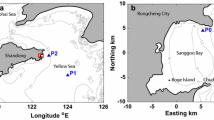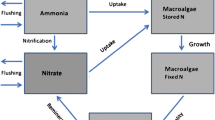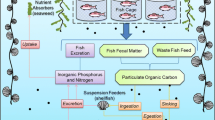Abstract
Reduced water quality is a potential outcome from intensive finfish aquaculture. Integrated multi-trophic aquaculture (IMTA) can mitigate the negative effects of dissolved nutrients emanating from fish farms by harvesting species that extract nutrients grown at adjacent sites. In this study, a coupled 3D hydrodynamic, sediment, and biogeochemical model was used to simulate an idealized temperate test estuary. A macroalgal-based IMTA model was applied within the estuarine model, to examine the spatial pattern of phytoplankton production arising from increasing levels of finfish aquaculture and the capacity of Macrocystis pyrifera to bioremediate the impacts of nutrification. Through increasing fish farm waste loads of dissolved inorganic nitrogen (DIN), the water quality in the estuarine model was forced into a “poor water quality” classification as determined by annual mean concentration of chlorophyll. Primary production was greatest in the northern section of the estuary due to circular water motion set up by a region of freshwater influence (ROFI). A nonlinear increase in annual phytoplankton biomass was simulated (under elevated finfish loads) due to the occurrence of an additional autumn phytoplankton bloom under elevated fish farm nutrient loads. IMTA scenario results demonstrated a strong spatial variability in the capacity of M. pyrifera-based IMTA to reduce water column chlorophyll concentration. Siting macroalgae farms next to those finfish farms situated in areas of high natural phytoplankton production resulted in a “good water quality” classification for the whole system. This demonstration of the use of IMTA to improve system wide water quality is valuable for regional planners and managers as it provides an analysis and quantification of a method to achieve estuarine health and economic benefit.










Similar content being viewed by others

References
Abreu MH, Varela DA, Henríquez L, Villarroel A, Yarish C, Sousa-Pinto I, Buschmann AH (2009) Traditional vs. Integrated Multi-Trophic Aquaculture of Gracilaria chilensis C. J. Bird, J. McLachlan & E. C. Oliveira: Productivity and physiological performance. Aquaculture 293:211–220
Anderson DM, Glibert PM, Burkholder JM (2002) Harmful algal blooms eutrophication: nutrient sources, composition, and consequences. Estuaries 25(4b):704–726
ANZECC. (2000). Australian and New Zealand Water Quality Guidelines for Fresh and Marine Sources. Canberra
Bonsdorff E, Blomqvist EM, Mattila J, Norrko A (1997) Coastal eutrophication: causes, consequences and perspectives in the archipelago areas of the northern Baltic Sea. Estuar Coast Shelf Sci 44:63–72
Bostock J, McAndrew B, Richards R, Jauncey K, Telfer T, Lorenzen K, Little D, Ross L, Handisyde N, Gatward I, Corner R (2010) Aquaculture global status and trends. Phil Trans R Soc 365:2897–2912
Broch OJ, Ellingsen IH, Forbord S, Wang X, Zsolt V, Alver MO, Skjermo J (2013) Modelling the cultivation and bioremediation potential of the kelp Saccharina latissima in close proximity to an exposed salmon farm in Norway. Aquacult Env Interact 4:187–206
Buschmann AH, Varela DA, Hernández-González MC, Huovinen P (2008) Opportunities and challenges for the development of an integrated seaweed-based aquaculture activity in Chile: determining the physiological capabilities of Macrocystis and Gracilaria as biofilters. J Appl Phycol 20:571–577
Buschmann AH, Cabello F, Young K, Carvajal J, Varela DA, Henrıquez L (2009) Salmon aquaculture and coastal ecosystem health in Chile: analysis of regulations, environmental impacts and bioremediation systems. Ocean Coast Manage 52:243–249
Carmona R, Kraemer GP, Yarish C (2006) Exploring Northeast American and Asian species of Porphyra for use in an integrated finfish–algal aquaculture system. Aquaculture 252:54–65
Clementson LA, Parslow JS, Turnbull AR, Bonham PI (2004) Properties of light absorption in a highly coloured estuarine system in south-east Australia which is prone to blooms of the toxic dinoflagellate Gymnodinium catenatum. Estuar Coast Shelf Sci 60:101–112
Cloern JE (2001) Our evolving conceptual model of the coastal eutrophication problem. Mar Ecol Prog Ser 210:223–253
Cloern JE, Foster SQ, Kleckner AE (2014) Phytoplankton primary production in the world’s estuarine-coastal ecosystems. Biogeosciences 11:2477–2501
Cromey CJ, Nickell TD, Black KD (2002) DEPOMOD—modelling the deposition and biological effects of waste solids from marine cage farms. Aquaculture 214:211–239
Dugdale R, Wilkerson F, Parker A, Marchi A, Taberski K (2012) River flow and ammonium discharge determine spring phytoplankton blooms in an urbanized estuary. Estuar Coast Shelf Sci 115:187–199
FAO (2009) Integrated mariculture a global review. Fisheries and Aquaculture Technical Paper. No. 529. FAO, Rome
FAO (2013) A global assessment of offshore mariculture potential from a spatial perspective. Fisheries and Aquaculture Technical Paper. No. 549. FAO, Rome
FAO (2014) ftp://ftp.fao.org/fi/stat/Overviews/AquacultureStatistics2012.pdf
Fujiwara T (2003) Buoyancy-driven current during cooling periods in Ise Bay, Japan. J Geophys Res 108:No. C8
Glibert PM, Dugdale R, Wilkerson F, Parker AE, Alexander J, Antell E, Blaser S, Johnson A, Lee J, Lee T, Murasko S, Strong S (2014) Major – but rare – spring blooms in 2014 in San Francisco Bay Delta, California, a result of the long-term drought, increased residence time, and altered nutrient loads and forms. J Exp Mar Bio Ecol 460:8–18
Gutierrez A, Correa T, Munez V, Santibanez A, Marcos R, Caceres C, Buschmann A (2006) Farming of the giant kelp Macrocystis pyrifera in southern Chile for development of novel food products. J Appl Phycol 18:259–267
Hadley S, Wild-Allen K, Johnson CJ, Macleod CK (2015) Modeling macroalgae growth and nutrient dynamics for integrated multi-trophic aquaculture. J Appl Phycol. 27:901–916
Hernandez-Garcia E, Lopez C (2004) Sustained plankton blooms under open chaotic flows. Ecol Complexity 1:253–259
Herzfeld M (2006) An alternative coordinate system for solving finite difference ocean models. Ocean Model 14:174–196
Herzfeld M, Gillibrand P (2015) Active open boundary forcing using dual relaxation time-scales in downscaled ocean models. Ocean Model 89:71–83
Herzfeld M, Schmidt M, Griffies SM, Liang Z (2010a) Realistic test cases for limited area ocean modelling. Ocean Model 37:1–34
Herzfeld M, Andrewartha J, Sakov P (2010b) Modelling the physical oceanography of the D’Entrecasteaux Channel and the Huon Estuary, south-eastern Tasmania. Mar Freshwat Res 61:568–586
Howarth RW (1988) Nutrient limitation of net primary production in marine ecosystems. Annu Rev Ecol Syst 19:89–110
Islam SM (2005) Nitrogen and phosphorus budget in coastal and marine cage aquaculture and impacts of effluent loading on ecosystem: review and analysis towards model development. Mar Pol Bull 50:48–61
Johnson CR, Banks SC, Barrett NS, Cazassus F, Dunstan PK, Edgar GJ, Frusher SD, Gardner C, Haddon M, Helidoniotis F, Hill KL, Holbrook NJ, Hosie GW, Last PR, Ling SD, Melbourne-Thomas J, Miller K, Pecl GT, Richardson AJ, Ridgway KR, Rintoul SR, Ritz DA, Ross DJ, Sanderson JC, Shepherd SA, Slotwinski A, Swadling KM, Taw N (2011) Climate change cascades: Shifts in oceanography, species’ ranges and subtidal marine community dynamics in eastern Tasmania. J Exp Mar Biol Ecol 400:17–32
Kapetsky JM, Aguilar-Manjarrez J, Jenness J (2013) A global assessment of potential for offshore mariculture development from a spatial perspective. FAO Fisheries and Aquaculture Technical Paper No. 549. FAO, Rome, p 181
Lansberg JH (2002) The effects of harmful algal blooms on aquatic organisms. Rev Fish Sci 10:113–390
Lem A, Bjorndal T, Lappo A (2014) Economic analysis of supply and demand for food up to 2030 – Special focus on fish and fishery products. FAO Fisheries and Aquaculture Circular No. 1089. FAO, Rome, p 106
Maier G, Glegg GA, Tappin AD, Worsfold PJ (2012) A high resolution temporal study of phytoplankton bloom dynamics in the eutrophic Taw Estuary (SW England). Sci Total Environ 434:228–239
Mann KH, Lazier JRN (1991) Dynamics of Marine Ecosystems: Biological-Physical Interactions inthe Oceans. Blackwell Scientific, Boston
Margvelashvili N (2008) Stretched Eulerian coordinate model of coastal sediment transport. Comput Geosci 35:1167–1176
Mongin M, Baird ME (2014). The interacting effects of photosynthesis, calcification and water circulation on carbon chemistry variablility on a coral reef flat: a modelling study. Ecol Model 284:19–34
Muylaert K, Tackx M, Vyverman W (2005) Phytoplankton growth rates in the freshwater tidal reaches of the Schelde estuary (Belgium) estimated using a simple light-limited primary production model. Hydrobiologia 540:127–140
Nixon SW (1989) An extraordinary red tide and fish kill in Narragansett Bay, in Novel Phytoplankton Blooms, Causes and Impacts of Recurrent Brown Tides and Other Unusual Blooms, Coastal and Estuarine Stud. 35:429–447
Ott MW, Garrett C (1998) Frictional estuarine flow in Juan de Fuca Strait, with implications for secondary circulation. J Geophys Res 103:No. C8
Paerl HW, Valdes LM, Peierls BL, Adolf JE, Harding LW (2006) Anthropogenic and climatic influences on the eutrophication of large estuarine ecosystems. Limnol Oceanogr 51:448–462
Phinney DA, Yentsch CS, Phinney DI (2004) Primary Productivity of Phytoplankton and Subtidal Microphytobenthos in Cobscook Bay, Maine. Ecosystem modeling in Cobscook Bay, Maine: A boreal, macrotidal estuary. Northeastern Naturalist 11(special edition 2):101–122
Pitta P, Tsapakis M, Apostolaki ET, Tsagaraki T, Holmer M, Karakassis I (2009) ‘Ghost nutrients’ from fish farms are transferred up the food web by phytoplankton grazers. Mar Ecol Prog Ser 374:1–6
Ren JS, Stenton-Dozeya J, Plew DR, Fang J, Galla M (2012) An ecosystem model for optimising production in integrated multitrophic aquaculture systems. Ecol Model 246:34–46
Ross DJ, Macleod CK (2012) Evaluation of broadscale environmental monitoring program (BEMP) data from 2009–2012. IMAS Technical Report 140pp
Saeck EA, Hadwen WL, Rissik D, O’brien KR, Burford MA (2013) Flow events drive patterns of phytoplankton distribution along a river - estuary - bay continuum. Mar Freshwat Res 64:655–670
Sanderson JC, Cromey CJ, Dring MJ, Kelly MS (2008) Distribution of nutrients for seaweed cultivation around salmon cages at farm sites in north–west Scotland. Aquaculture 278:60–68
Simpson JH (1997) Physical processes in the ROFI regime. J Phys Proc 12:3–15
Skerratt J, Wild-Allen K, Rizwi F, Whitehead J, Coughanowr C (2013) Use of a high resolution 3D fully coupled hydrodynamic, sediment and biogeochemical model to understand estuarine nutrient dynamics under various water quality scenarios. Oceean Coast Manag 10.1016/j.ocecoaman.2013.05.005.
Thompson PA, Bonham P, Wilcox S, Crawford C (2005) Baseline monitoring in D’Entrecasteaux Channel Technical report. CSIRO Marine and Atmospheric Research, Hobart, Tasmania
Thompson PA, Bonham PI, Swadling KM (2008) Phytoplankton blooms in the Huon Estuary, Tasmania: top-down or bottom up control. J Plankton Res 30:735–753
Troell M, Joyce A, Chopin T, Neori A, Buschmann AH, Fang JG (2009) Ecological engineering in aquaculture—potential for integrated multi-trophic aquaculture (IMTA) in marine offshore systems. Aquaculture 297:1–9
Wang X, Olsen LM, Reitan KI, Olsen Y (2012) Discharge of nutrient wastes from salmon farms: environmental effects, and potential for integrated multi-trophic aquaculture. Aquacul Env Interact 2:267–283
Westermeier R, Patiño DJ, Murúa P, Müller DG (2011) Macrocystis mariculture in Chile: growth performance of heterosis genotype constructs under field conditions. J Appl Phycol 23:819–825
Wild-Allen K, Herzfeld M, Thompson P, Rosebrock U, Parslow J, Volkman J (2010) Applied coastal biogeochemical modelling to quantify the environmental impact of fish farm nutrients and inform managers. J Mar Syst 81:134–147
Wild-Allen K, Skerratt J, Whitehead J, Rizwi F, Parslow J (2013) Mechanisms driving estuarine water quality: a 3D biogeochemical model for informed management. Estuar Coast Shelf Sci 135:33–45
Yoshiyama K, Sharp JH (2006) Phytoplankton response to nutrient enrichment in an urbanized estuary: apparent inhibition of primary production by overeutrophication. Limnol Oceanogr 51:424–434
Zhang J, Fang J, Wang W, Du M, Gao Y, Zhang M (2012) Growth and loss of mariculture kelp Saccharina japonica in Sungo Bay, China. J Appl Phycol 24:1209–1212
Acknowledgments
This work received funds from the Fisheries Research and Development Corporation (FRDC).
Author information
Authors and Affiliations
Corresponding author
Electronic supplementary material
Below is the link to the electronic supplementary material.
ESM 1
(DOCX 1.18 mb)
Rights and permissions
About this article
Cite this article
Hadley, S., Wild-Allen, K., Johnson, C. et al. Quantification of the impacts of finfish aquaculture and bioremediation capacity of integrated multi-trophic aquaculture using a 3D estuary model. J Appl Phycol 28, 1875–1889 (2016). https://doi.org/10.1007/s10811-015-0714-2
Received:
Revised:
Accepted:
Published:
Issue Date:
DOI: https://doi.org/10.1007/s10811-015-0714-2



